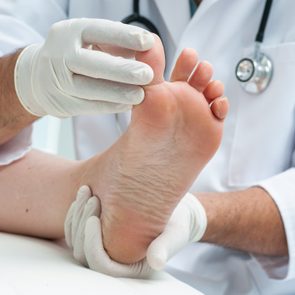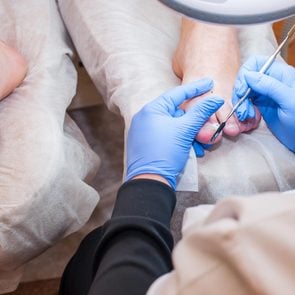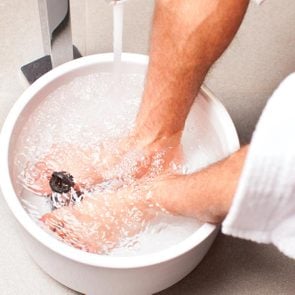6 Causes of Yellow Toenails and Treatments That Help
Updated: Jul. 21, 2024
From toenail fungus to certain types of nail polish, these are the causes—and how to get rid of—yellow toenails.
Our editors and experts handpick every product we feature. We may earn a commission from your purchases.
Why are my toenails yellow?
You might not pay much attention to your toes until flip-flop and sandal season rolls around, but you should. Toenails that are discolored yellow could point to something more than an unsightly cosmetic issue.
For the most part, yellowish-colored nails don’t pose a major health risk, but because they could be caused by a fungus or another underlying condition, a doctor’s visit is often in order.
Here are some reasons why nails become yellow, plus the other ways your nails can change, and how to treat it.
7 Things Your Nails Can Reveal About Your Health
Reasons why you have yellow toenails
Toenail fungus (onychomycosis)
The most common reason for toenails with a yellowish discoloration is nail fungus, scientifically known as onychomycosis.
You might pick up toenail fungus from either a break in the skin near or under the toenail from wearing tight and sweaty shoes, walking barefoot in moist and warm areas (think locker rooms, public showers, and pool decks), or if you have athlete’s foot.
Toenails fungus is rarely resolved with over-the-counter treatments. To effectively remove fungus, it usually takes several months of prescription medicine and medicated nail polish to be rid of the fungus for good.
But not all types of toenail fungus cause yellowish nails. Two subtypes may cause yellowish discoloration, streaks, or patches on the toenail.
Here’s What Happens If You Don’t Wash Your Feet, Says a Medical Doctor
Distal subungual onychomycosis is the most common of the subtypes. People with athlete’s foot are particularly susceptible.
The fungus appears on the toenail as a yellowish, white, or yellowish-brown discoloration, or the center of the toenail might have yellowish streaks. Jagged or chipped nails may eventually lift from the nail bed, and there may be some pain and inflammation.
9 Natural Home Remedies for Swollen Feet
Candida yeast infection is so similar to other forms of toenail fungus that it often requires additional laboratory testing to confirm it.
“However, some clues that Candida may be causing the infection are distal and lateral involvement of the nail, complete destruction of the nail itself, or partial destruction of the distal nail,” says dermatologist Joseph Zahn, MD, assistant professor of dermatology at the George Washington University Medical Faculty Associates, Washington, D.C.
It targets the soft tissue around the toenail first, causing the area to turn reddish. It then penetrates the toenail, resulting in yellow, white, or even brown discoloration that can become brittle and split, which might cause partial or total loss of the nail.
Here’s What It Means If You Have Ridges on Your Nails
Nail polish
Regularly wearing bright red and orange nail polishes may stain your nails a yellowish hue, especially near the top of your nails.
“The pigment can be removed by doing a longer acetone soak,” suggests Shari Lipner, MD, a dermatologist and associate professor of clinical dermatology at Weill Cornell Medicine, New York. Acetone, a powerful solvent, is the active ingredient in nail polish remover. Protect your skin first, and apply Vaseline around to each cuticle and the surrounding skin.
Another option is to take a break from nail polish and let the residue grow out gradually.
Are UV Nail Lamps Safe? What to Know When Getting a Gel Manicure
Nail psoriasis
About 80 to 90% of people with plaque psoriasis will develop nail psoriasis.
“Patients with nail psoriasis often have thick nails, with the lifting of the nail, and little indentations called pits,” says Dr. Lipner. It often causes pain, impacting daily activities.
“If the underlying cause is psoriasis, [with] the use of systemic treatments, the nail condition may improve,” adds dermatologist Pooja Sodha, MD, director of cosmetic dermatology at George Washington University Medical Faculty Associates, in Washington, D.C.
If psoriasis medication doesn’t help, treatments may include prescription corticosteroids, injections of corticosteroids, or certain retinoid creams applied to the nail. It’s also a good idea to keep the nails short and avoid trauma to the nails, Dr. Lipner says.
If you think you have nail psoriasis, call your dermatologist. Nail psoriasis is stubborn, and over-the-counter remedies won’t help.
Dermatologists Say This 1970s Anti-Aging Ingredient Is Still the Gold Standard for Gorgeous Skin
Ram’s horns (onychogryphosis)
Onychogryphosis, also known as ram’s horns, is a disorder of the nail plate growth that creates nails that look like the horns on a ram. “The nail develops an opaque, yellow-brown appearance associated with thickening, elongation, and increased curvature,” says Dr. Sodha.
If you Google “ram’s horns,” you’re likely to see startling images of very long and curvy nails. These pictures are a bit misleading because it takes a significant amount of time for the nails to grow out that long and curvy, which only happens if ram’s horns are left untreated. Toenail fungus, secondary nail infections, and ingrown toenails might emerge if treatment is delayed.
Ram’s horns tend to be hereditary. People with circulation problems, diabetes, and psoriasis are more at risk, as well as people who have a difficult time reaching their nails to clean and trim properly.
“Initial treatment is focused on reduction of the nail thickening and curvature, which may be performed with drills, burs, and clippers along with topical treatments to soften the nail plate, such as urea,” says Dr. Sodha. Next, your doctor will treat any underlying conditions such as psoriasis, diabetes, or trauma to the nail.
Yellow nail syndrome
Yellow nail syndrome is an extremely rare disorder, with only about 400 medical cases reported, according to the Orphanet Journal of Rare Diseases. It typically impacts people over 50 years old, but can affect younger people.
Yellow nail syndrome is characterized by yellowish fingernails and toenails, lymphedema (fluid collection and swelling), and recurring respiratory symptoms. The nail discoloration varies from a pale yellow to a greenish color. The nail becomes almost twice as thick as a normal nail but generally remains smooth. Nail growth stops and the cuticle disappears while the nail eventually lifts and separates from the nail bed.
People with yellow nail syndrome are at greater risk of developing a toenail fungus. Since this syndrome isn’t just about nails, treatment is focused on lymphedema, respiratory conditions, and any other symptoms the individual has. Often treating those symptoms will help reduce the yellowish nails and nail bed issues.
If fungus is present, toenail fungus treatment includes prescription anti-fungus pills and polishes. Corticosteroids and oral vitamin E may improve appearance and malformation.
5 Warning Signs Your Shoes Are Ruining Your Feet
Aging
Yellow toenails (and even fingernails) can be attributed to aging. With age, nails tend to change in color, thickness, and shape. These changes are considered normal and do not require any treatment. However, if you suspect or know you have an underlying medical condition, it’s always good to check with your doctor first to make sure it’s not a sign of something more serious.
Experts Say Most People Who Live to 100 Years Old Share This One Thing in Common
How to prevent yellow toenails
Spending a little extra time caring for your toes can reduce the risk of getting yellow toenails in the first place, especially when it comes to protecting yourself from fungus. Plus, regularly tending to your toes, can make you more likely to spot trouble early.
Here are some ways to ways to keep your toenails healthy and ward off injury and fungus.
- Keep your toenails short. Long toenails are more prone to breakage and injury. Be sure to cut them straight across, rounding slightly at the tips. Rounding too much can encourage nails to grow into the skin, creating painful ingrown toenails.
- Thick toenails can be more challenging to cut than thinner fingernails. Soak them in a warm bath first to soften them. Stir one teaspoon of salt per pint into the water and soak the toes for about 15 minutes.
- Ward off contagious toenail fungus by wearing flip-flops at the pool, public showers, and anywhere where surfaces are moist and warm.
- Wear properly fitting shoes and socks that breathe well. Fungus thrives in sweaty and warm environments.
- If you have redness, pain, pus, or other concerns, call your doctor or dermatologist. Medical evaluation is critical if you have diabetes or other circulation problems.






















